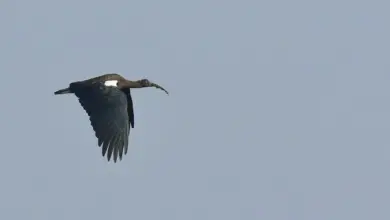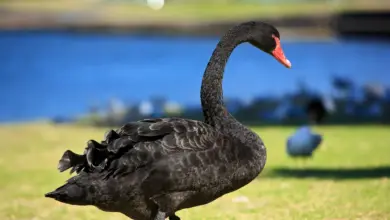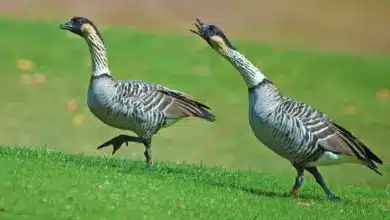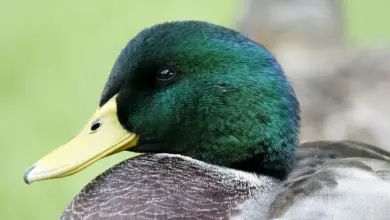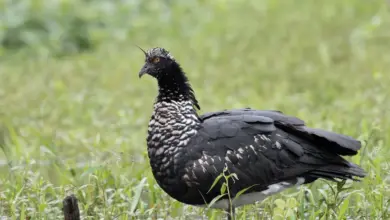The Bean Geese is a medium to large goose breeding in northern Europe and Asia. It is migratory and winters further south in Europe and Asia.
Its English and scientific names come from its habit in the past of grazing in bean field stubbles in winter (Latin faba, a bean).
It has been split into two species by the AOU (2007), however it is still regarded as a single species by the BOU – see below.
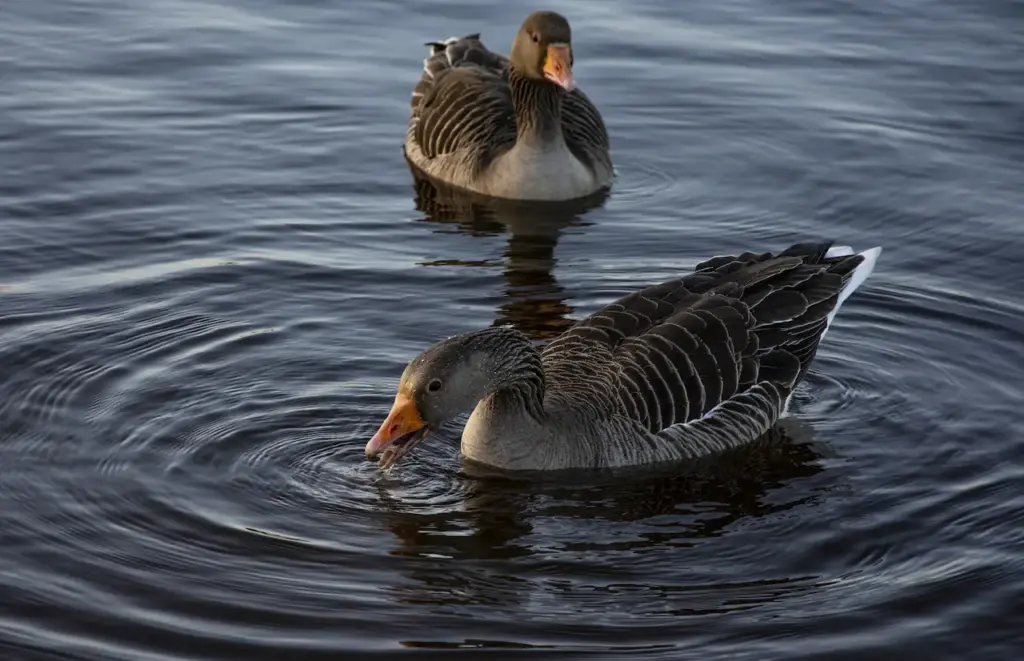
Distribution / Range
These medium-sized, dark-brown geese with orange and black bill and orange legs breed in northern Norway, northern Sweden and northern Finland.
They overwinter in the British Isles, southern Scandinavia, Germany, the Netherlands, and south to the Mediterranean Sea.
Description
The length ranges from 68 to 90 cm (27–36 in), wingspan from 140 to 174 cm (55–69 in) and weight from 1.7–4 kg (3.7-8.8 lbs).
The bill is black at the base and tip, with an orange band across the middle; the legs and feet are also bright orange.
The upper wing-coverts are dark brown, as in the White-fronted Goose (Anser albifrons) and the Lesser White-fronted Goose (A. erythropus), but differing from these in having narrow white fringes to the feathers.
Sub-species
There are five subspecies, with complex variation in body size and bill size and pattern; generally, size increases from north to south and from west to east. Some ornithologists (including AOU 2007) split them into two species based on breeding habitat, whether in forest bogs in the subarctic taiga, or on the arctic tundra.
- Taiga Bean Goose (Anser fabalis sensu stricto)
- A. f. fabalis. Scandinavia east to the Urals. Large; bill long and narrow, with broad orange band. Anser fabalis fabalis is one of the species to which the Agreement on the Conservation of African-Eurasian Migratory Waterbirds (AEWA) applies.
- A. f. johanseni. West Siberian taiga. Large; bill long and narrow, with narrow orange band.
- A. f. middendorffii. East Siberian taiga. Very large; bill long and stout, with narrow orange band.
- Tundra Bean Goose (Anser serrirostris, if treated as a distinct species)
- A. s. rossicus. Northern Russian tundra east to the Taimyr Peninsula. Small; bill short and stubby, with narrow orange band. Anser fabalis rossicus is one of the species to which the Agreement on the Conservation of African-Eurasian Migratory Waterbirds (AEWA) applies.
- A. s. serrirostris. East Siberian tundra. Large; bill long and stout, with narrow orange band.
The closely related Pink-footed Goose (A. brachyrhynchus) has the bill short, bright pink in the middle, and the feet also pink, the upper wing-coverts being nearly of the same bluish-grey as in the Greylag Goose. In size and bill structure, it is very similar to Anser fabalis rossicus, and in the past was often treated as a sixth subspecies of Bean Goose.
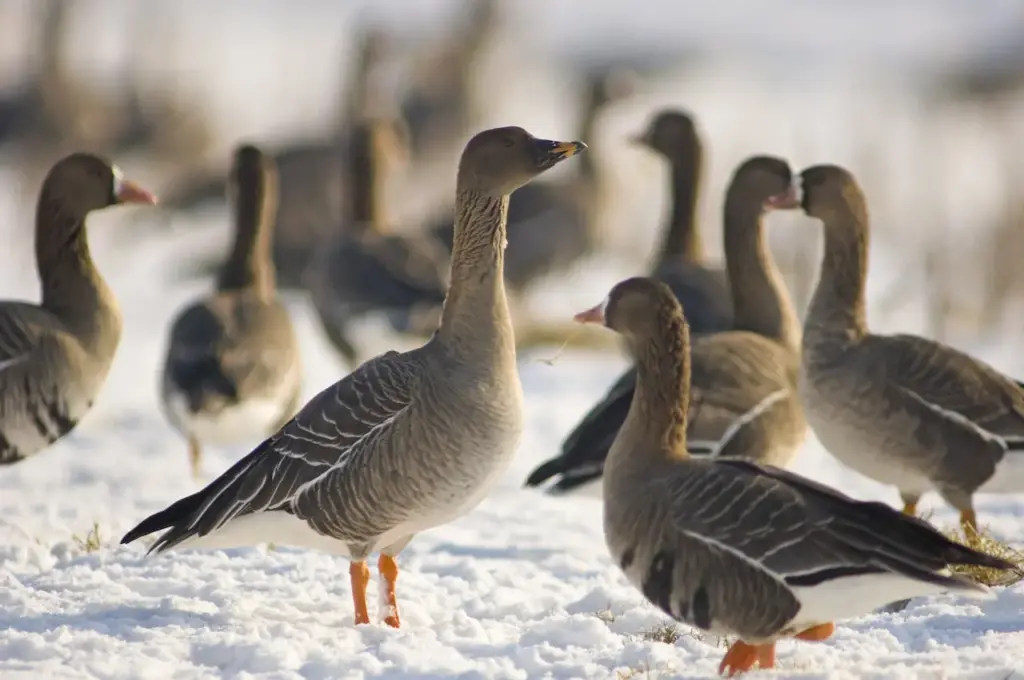
Calls / Vocalizations
The Bean Geese voice is a loud honking, higher pitched in the smaller subspecies.
Status in Britain
The Bean Geese is a rare winter visitor to Britain. There are two regular wintering flocks of Taiga Bean Goose, in the Yare Valley, Norfolk and the Avon Valley, Scotland. A formerly regular flock in Dumfries and Galloway no longer occurs there. Tundra Bean Goose has no regular wintering sites, but is found in small groups among other grey goose species – among the most regular locaities are WWT Slimbridge, Gloucestershire and Holkham Marshes, Norfolk.
Nesting / Breeding
Bean Geese reach breeding age when they are about 2 – 3 years old, with breeding typically starting in the spring / summer of their third year.
They typically nest at the foot of a tree or next to a fallen trunk.
The average clutch consists of 3 – 7 eggs, which are incubated for about 28 days.
References
- BirdLife International (2004). Anser fabalis. 2006. IUCN Red List of Threatened Species. IUCN 2006. Retrieved on 11 May 2006. Database entry includes justification for why this species is of least concern
Copyright: Wikipedia. This article is licensed under the GNU Free Documentation License. It uses material from Wikipedia.org … Additional information and photos added by Avianweb
Diet / Feeding:
Geese consume a wide variety of plant material, including grass, roots, shoots, leaves, stems, seedheads and fruits of other herbaceous marsh vegetation, aquatic plants, and agricultural grain and potatoes (particularly in the winter)
Feeding Ducks and Geese …
We all enjoy waterfowl and many of us offer them food to encourage them to come over and stay around – and it works! Who doesn’t like an easy meal!
However, the foods that we traditionally feed them at local ponds are utterly unsuitable for them and are likely to cause health problems down the road. Also, there may be local laws against feeding this species of bird – so it’s best to check on that rather than facing consequences at a later stage.
- Foods that can be fed to Ducks, Geese and Swans to survive cold winters and remain healthy when food is scarce in their environment.
Please note that feeding ducks and geese makes them dependent on humans for food, which can result in starvation and possibly death when those feedings stop. If you decide to feed them, please limit the quantity to make sure that they maintain their natural ability to forage for food themselves – providing, of course, that natural food sources are available.
Please Note: The images on this page are the sole property of the photographers (unless marked as Public Domain). Please contact the photographers directly with respect to any copyright or licensing questions. Thank you.

